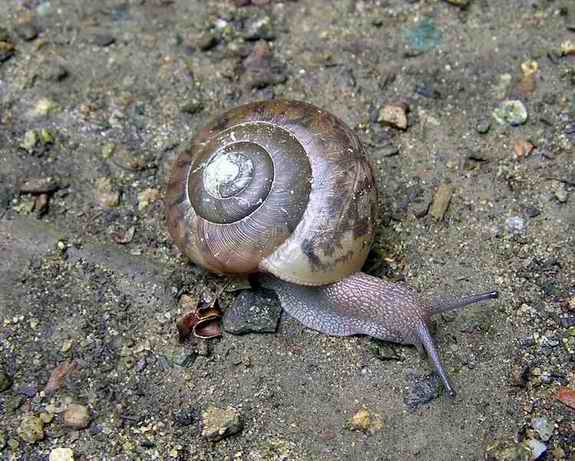|
Return to Hiker's Notebook Home Page
Common Name: Brown Garden Snail, European brown snail - The descriptive terms refer to characteristic coloration and habitat of this species; the etymology of snail is the Old English sn�gel which comes from Old High German snahhan meaning to creep.
Scientific Name: Helix aspersa - The generic name is a form of the Greek word for spiral, which is derived from helissein, meaning "to turn around"; the specific name is form the Latin aspersus, which means "a sprinkling," referring to the splotches of dark pigment on the shell.
The Brown Garden Snail, as its alternate name European brown snail attests, is not a native species; it was first described in 1774 in Italy. It has since spread globally due to the combination of its consumption as a delicacy food, by its unintentional association with exported plants, and through trade among malacologists (zoologists specializing in mollusks). It was first imported to California as a source of escargot (French for snail) in the middle of the 19th Century and has since become an agricultural pest. H. aspersa is known as "petit gris," meaning little gray, in France.
Land snails are mollusks of the class Gastropoda, which is from the Greek gaster, meaning stomach and poda, meaning foot; their locomotion would appear to be the result of an extension of the visceral mass that contains the stomach to produce a pedal appendage. They are ubiquitous; there are five hundred species native to the Eastern part of North America.
Snails are omnivorous, though they feed primarily on decayed wood and bark, fungi, and algae. However, they will eat virtually any organic material and many inorganic materials that they happen upon. This includes but is not limited to animal dung, insect frass, empty snail shells, carcasses, and even cement. Snails are equipped with a tongue-like organ with hard teeth that is called a radula. As the snail travels along a surface that it determines to be of nutritive value, the teeth of the radula rasp at the surface in a conveyor belt operation. Pieces of rasped off substrate are then carried into the pharynx for digestion.
Limestone and its cement derivatives are consumed by snails as a source of calcium, which is necessary for snail physiology. Calcium plays a role in fluid regulation, cell wall function, muscle contraction and the laying of eggs and, most importantly, in the formation and maintenance of their protective calcium carbonate shell. The snail's mantle is the shell building organ; it is a fold of tissue that develops a PH gradient that generates enough current to move the positively charged calcium ions in position on the exterior of the mantle, forming the shell.
The amount of calcium in the environment directly correlates to the number and diversity of the snail population; the incidence of acid rain reduces the calcium in forest soils and can lower snail populations by as much as 80 percent. Since the consumption of snails by predators is an important source of calcium in the food chain, the effect of acid rain is broadly extended; a recent study concluded that reduction in bird population with acid rain was due to the absence of snail calcium that led to eggshell thinning.
Snails do not move very far over a lifespan which can range from a few weeks to more that 5 years; studies have been conducted that indicate that movements range from about 6 to 30 meters per month depending on the degree of moisture in the area. Snails thus provide an excellent indication of ecological health of a given region. They have been used archaeologically to interpret ancient environments.
Most land snails are hermaphroditic, they have both male and female sexual organs; a single gonad produces both the egg and sperm. In spite of this, mating behavior is not atypical of other animal species. When two adults of the same species have an encounter, likely due to pheromones as snails can't see well and are typically nocturnal, they exhibit a courtship ritual of touching that may take hours. Once oriented in opposite directions with the right side of their heads together (where the sex organ is located), they engage in copulation in which one adult provides a spermatophore package to the other.
Oviposition for the Brown Garden Snail occurs about 5 days after fertilization; about 80 eggs are laid which hatch in about two weeks. As the hatchlings mature, a twisting motion occurs that creates a cavity into which the head can be retracted to thwart would-be predators. The movement of the mantle relative to the body is called torsion and results in the realignment of the anal opening to a position adjacent to the head. |
